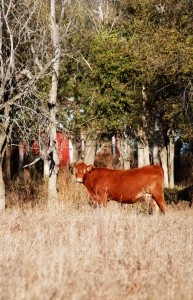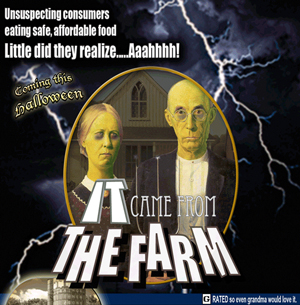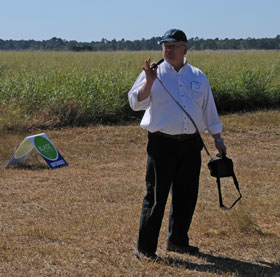 A group called the Vegetarian Society is standing up once again attribute global warming and the end to the universe to meat eaters. The article, Climate chief Lord Stern: give up meat to save the planet, published in Times Online, urged folks to turn vegetarian in order for the world to conquer climate change.
A group called the Vegetarian Society is standing up once again attribute global warming and the end to the universe to meat eaters. The article, Climate chief Lord Stern: give up meat to save the planet, published in Times Online, urged folks to turn vegetarian in order for the world to conquer climate change.
In an interview with The Times, Lord Stern of Brentford said: “Meat is a wasteful use of water and creates a lot of greenhouse gases. It puts enormous pressure on the world’s resources. A vegetarian diet is better.”
He predicted that people’s attitudes would evolve until meat eating became unacceptable. “I think it’s important that people think about what they are doing and that includes what they are eating,” he said. “I am 61 now and attitudes towards drinking and driving have changed radically since I was a student. People change their notion of what is responsible. They will increasingly ask about the carbon content of their food.”
This is absolute bogus and total hypocrisy. I recently compiled a top ten list of ways that meat production is beneficial to the environment, and I firmly believe that agriculturalists are the original environmentalists, serving as stewards of the land and care givers to the livestock. And, more importantly consumers should feel confident in serving a well-balanced, wholesome meal (that includes animal protein) to their families. It’s amazing how a few animal rights activists and trendy green advocates can create a buzz so big with their banter that they can actually change mainstream public perceptions on the good, wholesome food we eat. Thanks for the soap box. Now, here is a few statistics from my list…
1. American agriculture is sustainable for the future. In the United States, 98 percent of farms are family farms. Today’s American farmer feeds about 144 people worldwide. 2009 versus 1960: 1.8 million less farms are feeding a U.S. population that has increased 61 percent. (Explore Beef)
2. According to the Environmental Protection Agency, the entire U.S. agriculture sector accounts for only 6 percent of annual U.S. greenhouse gas emissions. Of this, livestock production is estimated to account for 2.8 percent of total U.S. emissions. (EPA Climate Change Report)
3. If livestock production disappeared tomorrow, wouldn’t we just be transporting more tofu around? And wouldn’t we just be plowing and fertilizing the land to supply PETA’s vegetarian utopia? (Center for Consumer Freedom)
4. Grazing animals on land not suitable for producing crops more than doubles the land area that can be used to produce food. If 1955 technology were used to produce the amount of beef raised today, 165 million more acres of land would be needed – that’s about the size of Texas! (Explore Beef)
 Getting down to the nitty gritty is part of what Commodity Classic is all about. It’s also about people who make their living off of the dirt. So, it’s fitting that the Grammy Award-winning Nitty Gritty Dirt Band will be on the Evening of Entertainment stage at the 2010 Commodity Classic convention and trade show in Anaheim, California.
Getting down to the nitty gritty is part of what Commodity Classic is all about. It’s also about people who make their living off of the dirt. So, it’s fitting that the Grammy Award-winning Nitty Gritty Dirt Band will be on the Evening of Entertainment stage at the 2010 Commodity Classic convention and trade show in Anaheim, California.

 Spammers, those who are lower than pond scum, are really hitting Twitter hard right now. I’ve received over 30 spam Direct Messages (DM’s) from people I follow this morning and I know my followers have received one from me. You can read an
Spammers, those who are lower than pond scum, are really hitting Twitter hard right now. I’ve received over 30 spam Direct Messages (DM’s) from people I follow this morning and I know my followers have received one from me. You can read an  A group called the Vegetarian Society is standing up once again attribute global warming and the end to the universe to meat eaters. The article,
A group called the Vegetarian Society is standing up once again attribute global warming and the end to the universe to meat eaters. The article,  If you’re interested in becoming the next Executive Director of the
If you’re interested in becoming the next Executive Director of the 
 I learned from Amanda Nolz that President Obama just signed into law more stimulus… for farmers! HR 2997 is actually the appropriations act for agriculture, rural development, the Food and Drug Administration, and other federal programs. It includes some increases that one would think will be good for South Dakota farmers…
I learned from Amanda Nolz that President Obama just signed into law more stimulus… for farmers! HR 2997 is actually the appropriations act for agriculture, rural development, the Food and Drug Administration, and other federal programs. It includes some increases that one would think will be good for South Dakota farmers… The
The  Have you ever wondered what switchgrass looks like? That’s it behind Cory Christensen, Director of Product Managment,
Have you ever wondered what switchgrass looks like? That’s it behind Cory Christensen, Director of Product Managment, 

 I talked with BIVI president George Heidgerken about the acquisition. “We’ll be expanding our business significantly, in fact, doubling our sales in the United States,” George says. “The product assets we’ve acquired from Fort Dodge are a broad range of strong brands in the cattle vaccine business. This is part of our long term strategy to improve our product offerings and our capabilities for the U.S. cattle producers and the U.S. cattle market.”
I talked with BIVI president George Heidgerken about the acquisition. “We’ll be expanding our business significantly, in fact, doubling our sales in the United States,” George says. “The product assets we’ve acquired from Fort Dodge are a broad range of strong brands in the cattle vaccine business. This is part of our long term strategy to improve our product offerings and our capabilities for the U.S. cattle producers and the U.S. cattle market.”